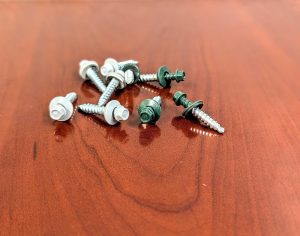Seeing as it’s Friday, I’ll give you a “shorty” today. At the beginning of this year my bride and I visited a horse barn facility in Florida we sold fall of 2010. This was a huge building and although our programs calculate just over a 5% overage cushion for screws, we really went heavy on this one. Let’s just say this client was “not so patient” and of course building in the fall of 2010, he was in an all fired hurry. We just didn’t want him calling with workers standing on the job to say he needed a pail of screws “over-nighted”.
And as best laid plans – this is exactly what he did. He claimed his builder “didn’t have enough roof screws”. The first thing I do is to go back through calculations and then shipping, to be sure he got sent the right number. Yep, they jived. I wondered what he did with all the roof screws, but went ahead and shipped him more anyway. It wasn’t until my wife and I visited his facility and took a closer look, we figured out where the shortage went. What we found also explained why he claimed his ridge cap “wasn’t wide enough”, so he had to add extra framing to his roof. His builder had errantly tried to screw the ridge cap to the ridge purlins, with the regular roofing screws! On top of that, the spacing of the purlins was wide enough, so he had to add a 2×4 on the “uphill” side of every ridge purlin, in order to have the wrong screws go into where they did not belong to begin with! Confused? Obviously they were.
On our building plans is a screw layout describing exactly what type of screws are used to do what – and where. Our Construction Guide also gives very specific instructions as to how and where to use the stitch screws.  Stitch screws are used to attach the ridge cap to the steel roofing. Evidently the builder had used the roof sheeting screws to put the ridge cap onto the building – screwing into the ridge purlins (well, almost into them). Now this explained his “issues”! You may ask, “What’s wrong with trying to do it this way?” Nothing structurally, but trying to depend on accuracy (or dumb luck) in trying to hit the ridge purlins while holding the ridge cap in place is a feat I would not want to attempt.
Stitch screws are used to attach the ridge cap to the steel roofing. Evidently the builder had used the roof sheeting screws to put the ridge cap onto the building – screwing into the ridge purlins (well, almost into them). Now this explained his “issues”! You may ask, “What’s wrong with trying to do it this way?” Nothing structurally, but trying to depend on accuracy (or dumb luck) in trying to hit the ridge purlins while holding the ridge cap in place is a feat I would not want to attempt.
Another reason for using stitch screws is aesthetics. You better hope those ridge purlins are exactly perfectly straight and hitting them with screws lined up equidistant from the edge on the ridge cap so you have straight screw lines. My head hurts just thinking about trying to make this work and look decent! OK, so I am really fussy, but there is nothing worse to me than having a beautiful building with screw lines looking as if someone stopped off for a six pack just prior to starting work for the day! This builder could have easily called, but instead he used more material and made a whole lot of work out of something designed to be not only very effective and attractive, but also….EASY.
OK, what do stitch screws do? Simply, they are #12 diameter, ¾” to 1-1/4” in length with ¼” hex head painted screw (powder coated if they come from our Hansen Buildings kits) used to stitch “metal to metal”. This means corner and rake trims and the ridge cap where they overlap wall steel. They have an EPDM washer for a water tight seal. Yes, they are meant for attaching steel to steel, and no, you don’t need “something wood underneath” to screw them into.
In a nutshell, this is all you need to know about stitch screws: use them to attach metal to metal, no wood underneath necessary.






